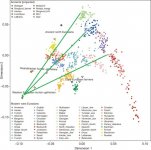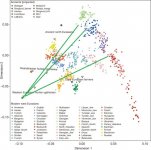Alan
Elite member
- Messages
- 2,517
- Reaction score
- 450
- Points
- 0
- Ethnic group
- Kurdish
- Y-DNA haplogroup
- R1a1a1
- mtDNA haplogroup
- HV2a1 +G13708A

On this map we see perfectly what Angela and I described. That it is the WHG admixture which gives the Europeans a parallel evolution to West Asians. In West Asians replace 30% of their total genome with WHG. And the West Asian line will almost overlap with the European line. North Caucasians will fall into North/Northeastern cluster and Levantines over the Spanish/Sardinian cluster. Which perfectly visualizes that Sardinians are ancient Levantines + additional WHG.
Attachments
Last edited:


